How much are the world’s biggest construction OEMs spending on R&D?
08 April 2024
The landscape of construction equipment never stays still for long.
That’s particularly the case at the moment, as manufacturers race to respond to the significant challenge of decarbonizing their machines at the same time as keeping up with the latest advancements in digital technology.
So it’s no surprise that the world’s biggest OEMs spend vast sums every year trying to stay one step ahead of their rivals in the fiercely contested field of research and development.
Construction Briefing takes a look at how much the top 10 companies in the world spend on R&D and what they spend it on.
The headline figure for each company (ranked in the order in which they appear in the latest Yellow Table) shows its research and development cost to sales ratio, rather than a monetary value.
That’s because some companies operate in multiple industry segments in addition to their construction activities and tend show only what their research and development costs were as they relate to the entire group. That can make the monetary value of what some companies invest look significantly higher than rivals whose activities focus purely on construction machinery:
1) Caterpillar: 3.1%
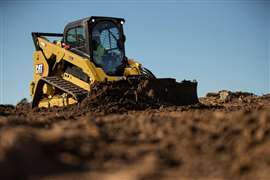 A Cat 299D3 compact tracked loader with a Smart Dozer Blade. Photo: Caterpillar
A Cat 299D3 compact tracked loader with a Smart Dozer Blade. Photo: Caterpillar
In its 2023 financial year, Caterpillar spent a total of $2.1 billion on research and development. That represents a 3.1% share of its total sales and revenue for the year and was an increase on the $1.8 billion it spent the previous year.
Caterpillar said that in its Construction Industries division, its R&D spending is focused on the next generation of construction machines, while in Resource Industries it aims to keep total cost of ownership down though making products as productive as possible.
Much of its research and development activities take place at its Technical Centres in Aurora and Mossville, Illinois.
It has forecast R&D spending of up to $2.5 billion in 2024. The company’s chief financial officer Andrew Bonfield told investors earlier this year that the company would spend more on autonomy, alternative fuels, connectivity and digital and electrification (AACE), as well as investing in making its supply chain more resilient. Meanwhile, the business will also invest in its large engine capacity.
2) Komatsu: 2.6%
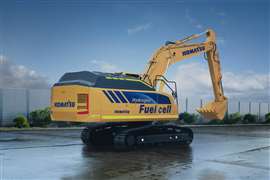 Komatsu’s new mid-sized concept excavator is powered by a hydrogen fuel cell. Photo: Komatsu
Komatsu’s new mid-sized concept excavator is powered by a hydrogen fuel cell. Photo: Komatsu
In its 2023 report, which relates to the 2022 financial year, Komatsu listed its research and development expenses as ¥90,628 million (US$605 million). That represents a 2.6% share of the company’s net sales for the year, which were ¥3,543,475 million (US$23.7 billion).
In construction equipment, Komatsu said that it is promoting the electrification of construction equipment, while advancing research and development on fuel cells, hydrogen engines and other new power sources.
The company is also working on a mobile battery bank with storage battery functionality for use in remote areas like mountainous regions where power sources might not be available.
In May 2023, it unveiled a concept for a medium-sized hydraulic excavator that combines hydrogen fuel cell and in-house developed key components. It is working on advancing proof of concept tests, ahead of embarking on commercial production of medium- and large-sized construction equipment powered by hydrogen fuel cells.
3) XCMG: 5% to 6%
When contacted by Construction Briefing, XCMG indicated that it spends between 5% and 6% of its annual revenue on research and development.
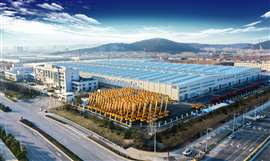 XCMG’s autonomous MEWP plant in China.
XCMG’s autonomous MEWP plant in China.
Last year, the company’s revenue was US$13.4 billion, which suggests that XCMG spent $670 million to $800 million on R&D.
The company did not give details on how it invests the money but has announced a host of innovations in terms of its own equipment and the facilities it uses to manufacture it in recent time that give an indication.
Late last year, the company opened an automated mobile elevated work platform (MEWP) factory in China, covering 170,000 sq m and kitted out with more than 120 robots and 25 production lines.
Early this year, XCMG also announced the successful trial of what it claimed is the world’s first vertical milling machine, the XVM160.
In December 2023, it showcased the world’s heaviest wheeled crane, the XCA3000, hoisting a 25t, 95m-long wind turbine blade into place at the Dashqiao Xintai New Energy 200 MW wind energy facility in China.
The company also announced last year that it would continue investing in the development of renewable energies such as electric, hydrogen and solar, deploying a batch of hydrogen-fuel-cell-powered loaders (XC968-FCEV) for use in coal mines in Shanxi, China.
4) Deere & Co: 3.9%
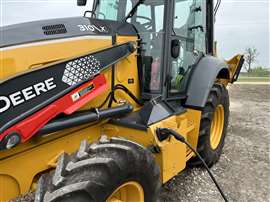 John Deere’s 310 X-Tier E-Power Backhoe Loader
John Deere’s 310 X-Tier E-Power Backhoe Loader
In its latest financial year, which ran to the end of October 2023, John Deere spent nearly $2.2 billion on research and development.
That was a 14% increase on the previous year, when it spent $1.9 billion. John Deere’s 2023 R&D spending represented a 3.9% share of its group-wide net sales of $55.6 billion.
It is worth noting that sales in John Deere’s construction and forestry division, which also includes brands such as Wirtgen, Vögele, Hamm and Kleemann, accounts for a relatively small share of the group’s overall sales, at 24%. The remaining 76% is accounted for by its agricultural machinery and financial services operations.
However, John Deere has published a group-wide figure for its research and development costs, which is not broken down by division.
The company said its research and development spend relates to intelligent solutions for its customers through digital capabilities, automation, autonomy, and alternative power technologies.
5) Sany: 5.9%
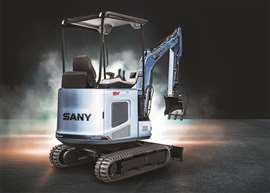 Sany’s SY19E electric mini excavator (Image: Sany)
Sany’s SY19E electric mini excavator (Image: Sany)
When contacted by Construction Briefing, Sany revealed that it spends around RMB5 billion (US$700 million) on R&D per year. Based on its most recently published annual turnover figure of $11.9 billion, that gives a cost-to-sales ratio of 5.9%.
Sany would not be drawn on precisely what it spends its R&D budget on. But new machine launches give an indication of the direction of travel.
Last year, it launched its first electric mini excavator, the SY19E, as well as a fully electric mid-sized excavator, the SY215E.
Meanwhile, at ConExpo in Las Vegas last year, the Chinese manufacturer released three new diesel-powered excavators: 37-ton SY335C LC, 41-ton SY385C, and its largest excavator to date, the 86.5-ton SY750H. These all featured new technology as standard including touchscreen monitor, heated seats, climate-controlled cab, push-to-start ignition and blind-side and rear-view cameras.
It also launched a ‘state-of-the-art’ carbon monitoring platform at the same show, which has already been deployed at its No.18 factory in China to measure energy efficiency.
The company is reported to be focusing on what it calls the “three modernisations” strategy of electrification, intelligence and internationalisation.
6) Volvo Group: 5%
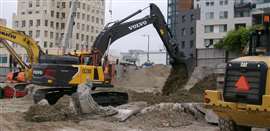 A Volvo EC230 Electric excavator does work in Los Angeles, US, as part of a pilot program run by Skanska. (Image: Skanska)
A Volvo EC230 Electric excavator does work in Los Angeles, US, as part of a pilot program run by Skanska. (Image: Skanska)
Volvo Group spent a total of SEK 26.6 billion (US$2.6 billion) on research and development in its 2023 financial year.
Like John Deere, however, that figure relates to spending across the entire group, which includes its trucks, buses and Volvo Penta operations.
Volvo Group’s R&D costs in 2023 were 5% of its net sales, and the SEK 26.6 billion it spent was the highest figure in five years, up from SEK 22.5 billion in 2022.
The company breaks down its R&D investments across four different categories: Just over a quarter (28%) of its spending went on low- and zero-emissions projects.
That was followed by 27% on ‘platform and enabler’ projects associated with the technology common to both conventional and low-/zero-emissions machines such as electrical architecture, cabs, aerodynamics, connectivity and safety features.
A further 11% went into research on fuel efficiency and environmental improvement projects relating to internal combustion engines, such as emissions reduction, bio-LNG and other low-carbon fuel projects.
And the remainder, totalling 34%, went on “neutral” projects some of which may have environmental benefits but have not been assessed as significant, according to Volvo.
7) Liebherr: 4.5%
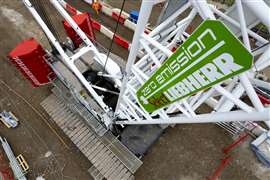 Zero emissions Liebherr electric crane at HS2’s Old Oak Common site. (Photo: HS2)
Zero emissions Liebherr electric crane at HS2’s Old Oak Common site. (Photo: HS2)
Liebherr’s most recent annual report, for the 2023 financial year, shows that it spent a total of €634 million (US$688 million) on research and development. On a turnover of €14 billion (US$15.2 billion), that represents a 4.5% cost to sales ratio.
The majority of Liebherr’s activities relate to construction and mining, through its earthmoving, materials handling, mobile and crawler cranes, tower cranes, concrete technology, mining and maritime cranes segments.
However, the business also operates in the refrigerators and freezers and aerospace and transportation systems sectors, which means that not all of the money the business invests in research and development necessarily ends up in construction applications.
As far as its R&D activities are concerned, the company said in its 2023 annual report that it was pursuing its objective to be a “major player in the advancement of technological innovation”. It said the bulk of the investment had been used to develop new products, with the fields of alternative drives, digitalisation and autonomy.
Recent innovations it has developed include a battery-powered wheel loader and telescopic handler, along with a study relating to a fuel-cell-powered wheel loader. The manufacturerʼs crawler excavator powered by a hydrogen combustion engine also made its world debut at Bauma 2022 and received the Innovation Award in the climate protection category.
Turning to digitalisation, Liebherr and some of its lead customers have been working on a joint project aimed at developing digital, machine-related solutions for the operational and strategic optimisation of machine fleets.
Liebherr is also a member of the VDMAʼs Machines in Construction (MiC) 4.0 working group. This develops solutions for consistent, manufacturer-independent digital communication between attachments and construction machines.
8) Hitachi Construction Machinery: 1.9%
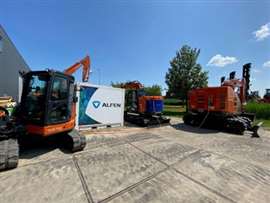 Hitachi battery powered excavators powered by an Alfens energy storage unit (Photo: Hitachi)
Hitachi battery powered excavators powered by an Alfens energy storage unit (Photo: Hitachi)
Hitachi construction machinery invested ¥24.4 billion (US$162.9 million) in research and development in its 2023 financial year. That was a cost to sales ratio of 1.9%, a fall from 2.5% in 2022 and 3% in 2021.
The company took various measures last year to strengthen its research and development activities, including relocating and consolidating its R&D bases for construction and mining machinery at its Tsuchuira Works in Japan.
In April 2023, it also established the Open Innovation Promotion Office in April 2023, which aims to facilitate collaboration with startups and specialized manufacturers in different fields. “We will strengthen open innovation focused on acquiring technologies from partners around the world, especially in rapidly advancing digital fields,” the company said.
Hitachi Construction Machinery said it was concentrating management resources in areas where it can achieve differentiation through research and development, such as hydraulic systems other than engines, or computer-based electronic control systems.
Meanwhile, it has been conducting open procurement for the power sources that drive hydraulic pumps, such as engines, while collaborating with procurement partners to give it the best options for electrification in the future.
9) Sandvik: 3.8%
Swedish OEM Sandvik’s latest annual report, for 2023, showed that its investment in R&D for the year was SEK4.8 billion (US$470 million), which corresponds to 3.8% of revenue.
The figure is for the entire Sandvik Group, which generates most of its revenue from mining, engineering and infrastructure activities. However, the company also operates in other sectors including automotive, aerospace and energy.
Each of the company’s business areas are responsible for their own research and development. Sandvik said its R&D activities focus on machining materials and process development, as well as additive manufacturing, powder metallurgy, electrification and digital solutions.
It has a portfolio of approximately 6,921 active patents and in 2023, it was granted a total of 722 new patents.
10) JCB: 3% (estimated)
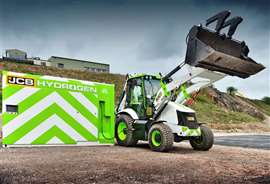 A JCB 4.8 L hydrogen engine, producing 70 kW, has been fitted into this JCB backhoe loader and is currently undergoing testing at a nearby proving ground in Staffordshire.
A JCB 4.8 L hydrogen engine, producing 70 kW, has been fitted into this JCB backhoe loader and is currently undergoing testing at a nearby proving ground in Staffordshire.
UK-based construction equipment manufacturer JCB does not publish data relating to its spending on research and development and declined to comment when contacted by Construction Briefing.
However, a Construction Equipment Association (CEA) report dating back to 2019 suggested that JCB’s R&D spend was 3% of revenue, with a focus on digitalisation and advanced telematics software.
JCB has also been at the forefront of developing a new hydrogen internal combustion engine, showcased at ConExpo in Las Vegas in 2023, which it has already fitted to a prototype backhoe loader and telehandler.
The company told the House of Lords in a submission that it was spending £100 million alone on hydrogen combustion R&D.
That doesn’t include its work on electrification starting with the launch of its 19C-IE fully electric mini excavator. The company now offers an extensive range of fully electric machinery, including site dumpers, telehandlers, access platforms, wheel loaders and articulated booms.
|
STAY CONNECTED



Receive the information you need when you need it through our world-leading magazines, newsletters and daily briefings.
CONNECT WITH THE TEAM









